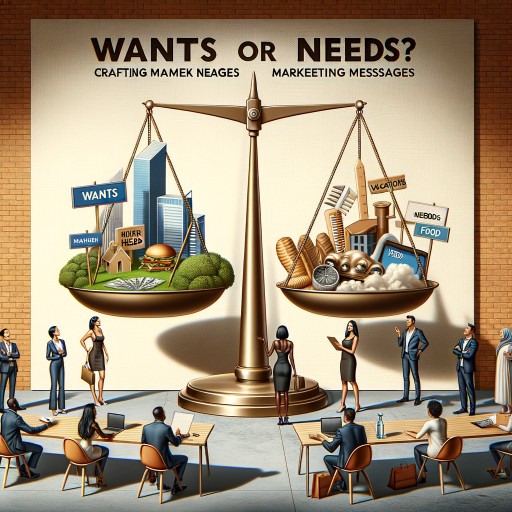Wants or Needs? Crafting Marketing Messages That Resonate

In the ever-evolving world of marketing, one perennial question continues to intrigue professionals: do consumers buy what they want or what they need? Understanding this distinction is crucial for crafting marketing messages that truly resonate with your audience. This blog post delves into the psychology behind consumer behaviour and provides actionable strategies for persuading potential customers that your product fits both their wants and needs.
The Psychology of Wants vs. Needs
At the core, human motivation can be driven by both wants and needs. Needs are essential for basic survival and well-being—think food, water, shelter, and healthcare. Wants, on the other hand, are more about desire and personal satisfaction, like luxury goods, entertainment, and fashion.
Maslow’s Hierarchy of Needs provides a useful framework for understanding consumer motivation. At the base are physiological needs, followed by safety, love and belonging, esteem, and self-actualisation. Generally, people will first satisfy their basic needs before progressing to higher levels. However, modern consumer behavior is more complex, and the lines between wants and needs often blur. A smartphone, for instance, might start as a need for communication but quickly evolve into a want for its entertainment capabilities, aesthetic design, or social status.
Strategies to Persuade Consumers
Emotional Appeals
Emotions are powerful drivers of decision-making. Even when purchasing necessities, consumers often choose products that resonate emotionally. Create marketing messages that evoke feelings like happiness, trust, fear, or nostalgia. Case studies, user testimonials, and stories can help connect your product emotionally with your audience.
Example:
Instead of just stating that your organic snack bars are nutritious, highlight how they bring families together for happy, shared moments. A family enjoying your product in a serene picnic setup can evoke feelings of unity and joy, making the purchase more appealing.
Logical Appeals
While emotions are influential, consumers also appreciate logical reasons for their purchases. Back your emotional appeals with data, statistics, and clear benefits. This dual approach of appealing to both the heart and the head can be very effective.
Example:
Showcase how your software saves time and money for businesses by presenting clear statistics. Pair this with testimonials from satisfied customers who found their work-life balance improved as a result.
Scarcity and Urgency
Scarcity creates perceived value and drives urgency. Limited-time offers, exclusive deals, and low-stock alerts make products more desirable. The underlying psychology is that consumers fear missing out—this “FOMO” can be a compelling motivator.
Example:
A flash sale that offers a 20% discount on a popular item for just 24 hours can push hesitant buyers to make immediate decisions, thinking they might lose an opportunity they won’t get again.
Social Proof
People are naturally inclined to follow the actions of others. Social proof, such as reviews, ratings, and testimonials, serves as a potent persuasion tool. Highlight customer feedback, endorsements from influencers, and case studies to build trust and credibility.
Example:
Displaying a customer review section prominently on your product page allows potential buyers to see real-world validation, making them more likely to follow suit.
Tailored Messaging
Personalisation can significantly boost the effectiveness of your marketing efforts. Use data analytics to segment your audience and create tailored messages that address specific needs and wants. Personalised emails, targeted ads, and product recommendations can help make your offering more relevant to individual consumers.
Example:
An e-commerce website that suggests products based on browsing history shows consumers items that align with their interests, effectively merging wants with perceived needs.
Integrating Wants and Needs
The most successful marketing strategies synthesize both wants and needs. Highlight the practical benefits (needs) while also showcasing the aspirational aspects (wants) of your product.
A powerful message should communicate how your product solves a problem or fulfills a need while simultaneously appealing to desires and aspirations. This approach ensures that your marketing resonates on multiple levels, making it far more compelling.
Example:
A fitness tracker might need to highlight its accuracy and health benefits to meet a consumer’s fitness requirements. Simultaneously, showcasing sleek design and features that allow social media sharing can cater to the want for social validation and style.
Whether a consumer purchases based on want or need often depends on the situation and individual motivations. By crafting marketing messages that address both these aspects effectively, marketers can create a more profound connection with their audience. Emotional storytelling, logical benefits, urgency, social proof, and personalised messaging are key strategies. By integrating these elements, it’s possible to persuade potential customers that your product perfectly meets both their wants and needs.
OH, and by the way, If you need help creating all the content styles and types for your marketing, have you considered using AI apps?
Whether you WANT an easy route to getting more things done faster, with your supervision rather than total direct input, or NEED help with some of the tasks you don’t feel you are an expert in yet…
Then do pop along to https://RandysApps.com – where you can browse through a selection of AI Apps for Marketers that might just be what you both WANT and NEED to help you make progress in your marketing. 🙂
Randy Smith
